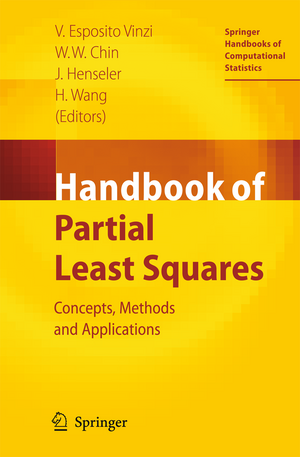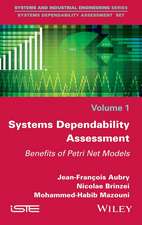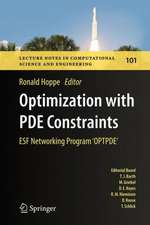Handbook of Partial Least Squares: Concepts, Methods and Applications: Springer Handbooks of Computational Statistics
Editat de Vincenzo Esposito Vinzi, Wynne W. Chin, Jörg Henseler, Huiwen Wangen Limba Engleză Hardback – 26 feb 2010
| Toate formatele și edițiile | Preț | Express |
|---|---|---|
| Paperback (1) | 2765.86 lei 6-8 săpt. | |
| Springer Berlin, Heidelberg – 9 aug 2016 | 2765.86 lei 6-8 săpt. | |
| Hardback (1) | 2771.22 lei 6-8 săpt. | |
| Springer Berlin, Heidelberg – 26 feb 2010 | 2771.22 lei 6-8 săpt. |
Preț: 2771.22 lei
Preț vechi: 3379.54 lei
-18% Nou
Puncte Express: 4157
Preț estimativ în valută:
530.32€ • 550.32$ • 443.27£
530.32€ • 550.32$ • 443.27£
Carte tipărită la comandă
Livrare economică 15-29 martie
Preluare comenzi: 021 569.72.76
Specificații
ISBN-13: 9783540328254
ISBN-10: 3540328254
Pagini: 814
Ilustrații: XIV, 798 p.
Dimensiuni: 155 x 235 x 48 mm
Greutate: 1.27 kg
Ediția:2010
Editura: Springer Berlin, Heidelberg
Colecția Springer
Seria Springer Handbooks of Computational Statistics
Locul publicării:Berlin, Heidelberg, Germany
ISBN-10: 3540328254
Pagini: 814
Ilustrații: XIV, 798 p.
Dimensiuni: 155 x 235 x 48 mm
Greutate: 1.27 kg
Ediția:2010
Editura: Springer Berlin, Heidelberg
Colecția Springer
Seria Springer Handbooks of Computational Statistics
Locul publicării:Berlin, Heidelberg, Germany
Public țintă
Academic/professional/technical: Research and professionalCuprins
Editorial: Perspectives on Partial Least Squares.- METHODS.- Latent Variables and Indices: Herman Wold#x2019;s Basic Design and Partial Least Squares.- PLS Path Modeling: From Foundations to Recent Developments and Open Issues for Model Assessment and Improvement.- Bootstrap Cross-Validation Indices for PLS Path Model Assessment.- A Bridge Between PLS Path Modeling and Multi-Block Data Analysis.- Use of ULS-SEM and PLS-SEM to Measure a Group Effect in a Regression Model Relating Two Blocks of Binary Variables.- A New Multiblock PLS Based Method to Estimate Causal Models: Application to the Post-Consumption Behavior in Tourism.- An Introduction to a Permutation Based Procedure for Multi-Group PLS Analysis: Results of Tests of Differences on Simulated Data and a Cross Cultural Analysis of the Sourcing of Information System Services Between Germany and the USA.- Finite Mixture Partial Least Squares Analysis: Methodology and Numerical Examples.- Prediction Oriented Classification in PLS Path Modeling.- Conjoint Use of Variables Clustering and PLS Structural Equations Modeling.- Design of PLS-Based Satisfaction Studies.- A Case Study of a Customer Satisfaction Problem: Bootstrap and Imputation Techniques.- Comparison of Likelihood and PLS Estimators for Structural Equation Modeling: A Simulation with Customer Satisfaction Data.- Modeling Customer Satisfaction: A Comparative Performance Evaluation of Covariance Structure Analysis Versus Partial Least Squares.- PLS in Data Mining and Data Integration.- Three-Block Data Modeling by Endo- and Exo-LPLS Regression.- Regression Modelling Analysis on Compositional Data.- APPLICATIONS TO MARKETING AND RELATED AREAS.- PLS and Success Factor Studies in Marketing.- Applying Maximum Likelihood and PLS on Different Sample Sizes: Studieson SERVQUAL Model and Employee Behavior Model.- A PLS Model to Study Brand Preference: An Application to the Mobile Phone Market.- An Application of PLS in Multi-Group Analysis: The Need for Differentiated Corporate-Level Marketing in the Mobile Communications Industry.- Modeling the Impact of Corporate Reputation on Customer Satisfaction and Loyalty Using Partial Least Squares.- Reframing Customer Value in a Service-Based Paradigm: An Evaluation of a Formative Measure in a Multi-industry, Cross-cultural Context.- Analyzing Factorial Data Using PLS: Application in an Online Complaining Context.- Application of PLS in Marketing: Content Strategies on the Internet.- Use of Partial Least Squares (PLS) in TQM Research: TQM Practices and Business Performance in SMEs.- Using PLS to Investigate Interaction Effects Between Higher Order Branding Constructs.- TUTORIALS.- How to Write Up and Report PLS Analyses.- Evaluation of Structural Equation Models Using the Partial Least Squares (PLS) Approach.- Testing Moderating Effects in PLS Path Models: An Illustration of Available Procedures.- A Comparison of Current PLS Path Modeling Software: Features, Ease-of-Use, and Performance.- to SIMCA-P and Its Application.- Interpretation of the Preferences of Automotive Customers Applied to Air Conditioning Supports by Combining GPA and PLS Regression.
Recenzii
From the reviews:
“I found the book to be a good resource for those without prior knowledge of PLS looking forward to an introduction as well as a comprehensive reference for every researcher and every practitioner interested in the most recent advances in PLS methodology. All of them should have this title as an essential part of their library. … Great Stuff! … will be the definitive reference work in the field for a good time to come. … it is wonderfully readable and referable.” (Current Engineering Practice, August, 2011)
“The book is divided into three parts, dealing, respectively, with contemporary methodological developments, applications in marketing and related areas, and tutorials on particular aspects of PLS analysis. It provides a comprehensive overview of recent advances in the area, and describes cutting-edge methodological developments showing how PLS can be applied in tackling a wide variety of problem types. … for people who do have some prior experience with PLS, this book is a goldmine of novel methodological and practical applications.” (David J. Hand, International Statistical Review, Vol. 80 (3), 2012)
“I found the book to be a good resource for those without prior knowledge of PLS looking forward to an introduction as well as a comprehensive reference for every researcher and every practitioner interested in the most recent advances in PLS methodology. All of them should have this title as an essential part of their library. … Great Stuff! … will be the definitive reference work in the field for a good time to come. … it is wonderfully readable and referable.” (Current Engineering Practice, August, 2011)
“The book is divided into three parts, dealing, respectively, with contemporary methodological developments, applications in marketing and related areas, and tutorials on particular aspects of PLS analysis. It provides a comprehensive overview of recent advances in the area, and describes cutting-edge methodological developments showing how PLS can be applied in tackling a wide variety of problem types. … for people who do have some prior experience with PLS, this book is a goldmine of novel methodological and practical applications.” (David J. Hand, International Statistical Review, Vol. 80 (3), 2012)
Textul de pe ultima copertă
The "Handbook of Partial Least Squares (PLS) and Marketing: Concepts, Methods and Applications" is the second volume in the series of the Handbooks of Computational Statistics. This Handbook represents a comprehensive overview of PLS methods with specific reference to their use in Marketing and with a discussion of the directions of current research and perspectives. The Handbook covers the broad area of PLS Methods from Regression to Structural Equation Modeling, from methods to applications, from software to interpretation of results. The Handbook features papers on the use and the analysis of latent variables and indicators by means of the PLS Path Modeling approach from the design of the causal network to the model assessment and improvement. Moreover, within the PLS framework, the Handbook addresses, among others, special and advanced topics such as the analysis of multi-block, multi-group and multi-structured data, the use of categorical indicators, the study of interaction effects, the integration of classification issues, the validation aspects and the comparison between the component-based PLS approach and the covariance-based Structural Equation Modeling. Most chapters comprise a thorough discussion of applications to problems from Marketing and related areas. Furthermore, a few tutorials focus on some key aspects of PLS analysis with a didactic approach. This Handbook serves as both an introduction for those without prior knowledge of PLS as well as a comprehensive reference for researchers and practitioners interested in the most recent advances in PLS methodology.
Caracteristici
Up-to-date review of the PLS methods recently developed and their applications in marketing Complete and comprehensive overview of the field Focus both on statistical methodology and selected real world problems Includes supplementary material: sn.pub/extras



















